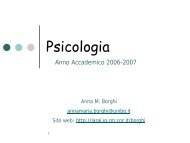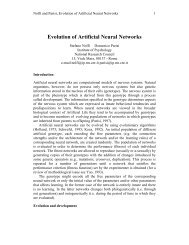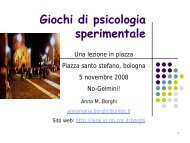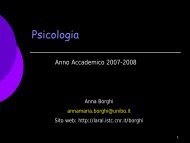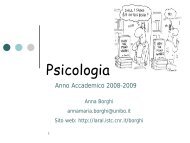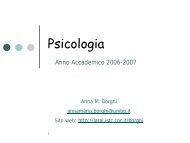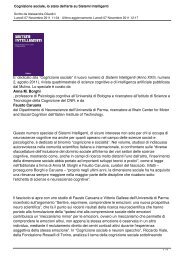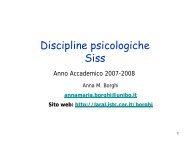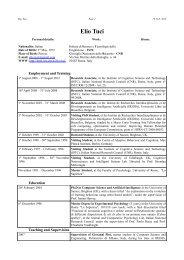Moving hands, moving entities. Annalisa Setti, Anna M ... - LARAL
Moving hands, moving entities. Annalisa Setti, Anna M ... - LARAL
Moving hands, moving entities. Annalisa Setti, Anna M ... - LARAL
You also want an ePaper? Increase the reach of your titles
YUMPU automatically turns print PDFs into web optimized ePapers that Google loves.
prime hand posture (power, precision) and the object size (large, small), but this<br />
occurred provided that participants received motor training, which required them to<br />
imitate the gestures displayed in the hand-pictures (see also Bazzarin, Borghi, Tessari<br />
& Nicoletti, 2007). The training might be necessary for participants to allow them to<br />
capture the static hand posture as a ‘snapshot’ of a <strong>moving</strong> grasping action, i.e. to<br />
enhance the implied motion evoked by the hand. Vainio, Symes, Ellis, Tucker &<br />
Ottoboni (2008) found similar congruency effects between a hand prime and a target<br />
object, but they presented videos instead of static images of the grasping hand. Fischer,<br />
Prinz and Lotz (2008) found that seeing different hand postures automatically directs<br />
attention towards congruent target objects, but they used hand postures the position of<br />
which varied dynamically over time. Whether or not the observation of a static<br />
depiction of a manual action is sufficient to activate the MNS remains unclear.<br />
Studies on implied motion have focused on the differences between observation of<br />
static or <strong>moving</strong> actions showing that static photographs characterised by implied motion<br />
(Freyd, 1983) activate brain regions involved in visual motion processing (Kourtzi &<br />
Kanwisher, 2000). In a recent fMRI study by Nelissen, Luppino, Vanduffel, Rizzolatti,<br />
& Orban (2005) monkeys viewed videos displaying human <strong>hands</strong> performing an action<br />
with or without an object. Videos with actions and motion of the object were compared<br />
with static photographs. Static images of mimicked actions did not show much activation<br />
on the mirror neurons areas or on Brodmann area 45, where information on objects and<br />
on action converges. However, activation did occur when videos were used. In contrast,<br />
in another fMRI study with humans Johnson-Frey, Maloof, Newman-Norlund, Farrer,<br />
Inati and Grafton (2003) showed that observing static pictures of the same objects being<br />
grasped or touched is sufficient to selectively activate the frontal mirror region. In a<br />
Transcranial Magnetic Resonance (TMS) study Urgesi, Moro, Candidi, Aglioti (2006)<br />
presented participants with static pictures of either a resting hand, a grasping hand in<br />
6



